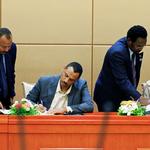Transforming Pastoralist Mobility in West Darfur: Understanding Continuity and Change
In the Darfur Region of Sudan, patterns of livestock mobility and livelihood systems are continually adapting and transforming themselves in the face of multiple challenges. Earlier studies have shown that pastoralist mobility offers significant production advantages and enables pastoralist herds to access the best-quality grazing during the rainy season as they selectively target the new, more nutritious growth. Mobility also allows pastoralists to minimize time spent in difficult conditions (mud, flies, and overcrowding or overgrazing), while also maintaining dry season pasture and fodder reserves.
Some of the challenges to livestock production are well known and documented. However, little is known about how livestock keepers cope with and manage extreme climate variability, and potential insecurity and conflict, and how this coping differs according to systems of livestock production and mobility patterns. In 2017, we undertook a study to improve our knowledge of these factors in West Darfur, Sudan.
Using Global Positioning System (GPS) tracking devices, we tracked livestock herds (sheep, cattle, and camel) of 13 livestock keepers for six months, from April to September 2017. The herds came from two areas in West Darfur: El Geneina Locality (Telehaya) and Kulbus Locality (Goshosh and Bir Taweel). We used the GPS data to produce maps illustrating the movements of each herd during part of the hot dry season (seif), the rainy season (kharif), and the pre-harvest and harvest period (deret). These are the seasons when interaction between herders and farmers are most active. The maps allow a comparative analysis by season, by livestock species, and by pattern of mobility (distant, close, or sedentary). The annual cycle of mobility differs according to whether livestock keepers are specialists in farming (Goshosh and Bir Taweel communities) or in pastoralism (Telehaya community). The traditional livestock corridors (murhal) linking the rainy season grazing areas in the far north on the edge of the Sahara with the dry season grazing areas in the south extend from 500 to 600 kilometers (km).
At the other end of the spectrum is the more localized mobility of small herds owned by farmers in the vicinity of their villages. Patterns of mobility have changed. We identify three territories of movement, or grazing zones: home area (1–5 km); close grazing land (6–19 km); and distant grazing land (20–100 km). Compared to the past, these territories are retracting closer to the home area.
The livestock keepers who practice long-distance mobility divide their cycle of movement between the three zones. They spend seif, rushash (season in which the rains begin), and kharif in the distant grazing land away from their home area. Towards the time of harvest, they proceed to their home area to benefit from the talaig (the practice of common access of livestock to graze crop residues after the harvest has been taken in), where they stay for the whole of shita (cool dry season), grazing on crop residues and pastures around the village. Shortdistance mobility is concentrated in the close grazing zone and is the most popular zone in both communities, with herds spending about 45% of their annual cycle of movement in this zone. As a result, livestock keepers report that pasture is rapidly deteriorating due to the high concentration of livestock. In the sedentary system of mobility,
livestock grazing is confined to the home area all year round. This sedentary system is practiced by settled communities, primarily farmers; however,
pastoralists also do this when facing periods of conflict or threat of looting.
All livestock keepers in this study identified insecurity as their predominant concern. The restricted patterns of mobility described above are a preventive response strategy to counter security risks. Livestock keepers avoid remote pastureland that might put them at risk from bandits and armed groups. Additionally, the lack of water for livestock in the distant northern part of the migration is pushing livestock keepers to reduce the time spent there
despite the availability of quality pasture. As a result, livestock keepers must make trade-offs between the threat of insecurity and looting versus the risks of overgrazing, poor-quality pasture, overcrowding, and disease. Thus, livestock keepers design and manage the annual cycle of movement to sustain and protect their herds and support household food security and other livelihood goals.
Dry years (mahal) and floods are characteristic of this region, some more severe than others. For example, Telehaya livestock keepers described the
effects of the 2017 mahal as particularly bad because of the competition from camel herds from Chad for limited water and fodder resources. Significant
livestock deaths were reported. Drought coping strategies include higher frequency movement, tree cutting to use seeds and pods as fodder, use of feed concentrates, and destocking. These strategies risk overgrazing and degradation of tree cover. Flash floods during the early rains are also dangerous, as livestock are concentrated around the wadi (valley that has a seasonal water course). There is little pastoralists can do to avoid this danger. Conflict responses include: keeping small livestock herds within the village; moving larger, more mobile herds in bigger groups to support each other; using guard dogs to watch livestock at nighttime; looking for alternative, but longer, routes when corridors are blocked; and reducing the pattern of distant mobility. None of these responses adequately address the problems faced, and so there is a need for a more collaborative and considered institutional, policy, and programmatic response involving discussing the issues with both the local- and state-level authorities and other stakeholders. The report presents provisional recommendations to serve as the basis for further discussion.


![Engasjert antropologi i turbulente tider [Engaged Anthropology in Turbulent Times].](http://www.cmi.no/img/400/19475-Screenshot-2025-12-25-at-180604.png)
![Å holde flammen tent: Engasjert antropologi i mørke tider [Tending the flame: Engaged anthropology in dark times]](http://www.cmi.no/img/400/19474-Screenshot-2025-12-25-at-175845.png)
![Ti år med flyktningkriser og folkerettsbrudd i Europa (2015–2025): Kunne EU og Norge ha svart annerledes? [A Decade of Refugee Crises and Violations of International Law in Europe (2015-2025) – Could the EU and Norway Have Responded Differently?]](http://www.cmi.no/img/400/19473-Screenshot-2025-12-25-at-173706.png)
